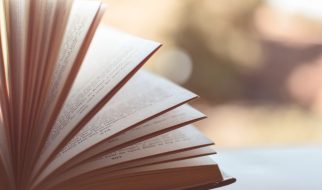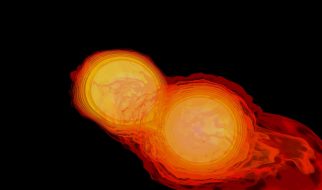True Detective resonated with me the way no other TV series ever did.
Sure, it?s about The Weird, the best intro sequence ever created, that opening song, the Louisiana psychosphere, McConaughey and Harrelson becoming Cohle and Hart, nihilism, Ligotti and and Moore, the occult, serial killers, Alexandra Daddario and ten thousand other things?
?but my favorite thing is The Puzzle. Spoilers ahead.
Sometimes, it?s the literal puzzle.
Let?s look at the journey of the reveal of the killer. In the second half of the series, the FBI agents make it clear that Rust himself is a suspect. But, through symbolism, this idea is planted in the viewer?s head much earlier. Here?s Rust in the first episode:
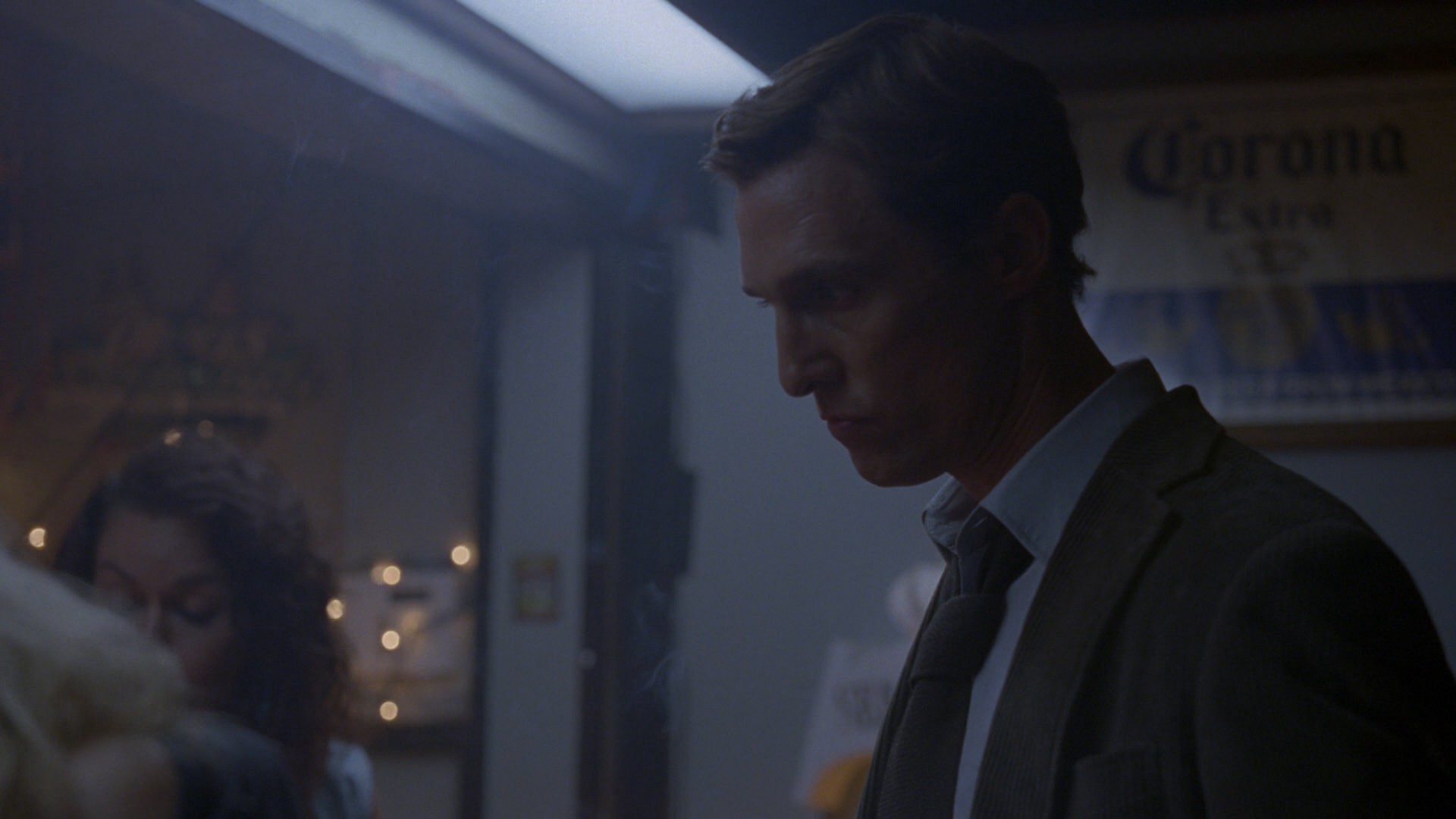
Notice the Corona logo next to him. Corona means ?crown? in Spanish, and their logo is indeed a crown. A yellow one. And we know from the series that the killer might be someone called ?The Yellow King? (ultimately that?s not the case, but we don?t know that until the final episode where we learn that the Yellow King is not the killer but the killer?s creation).
Later, in the third episode, we have another shot of Rust next to a ?king? with a yellow ?crown?:
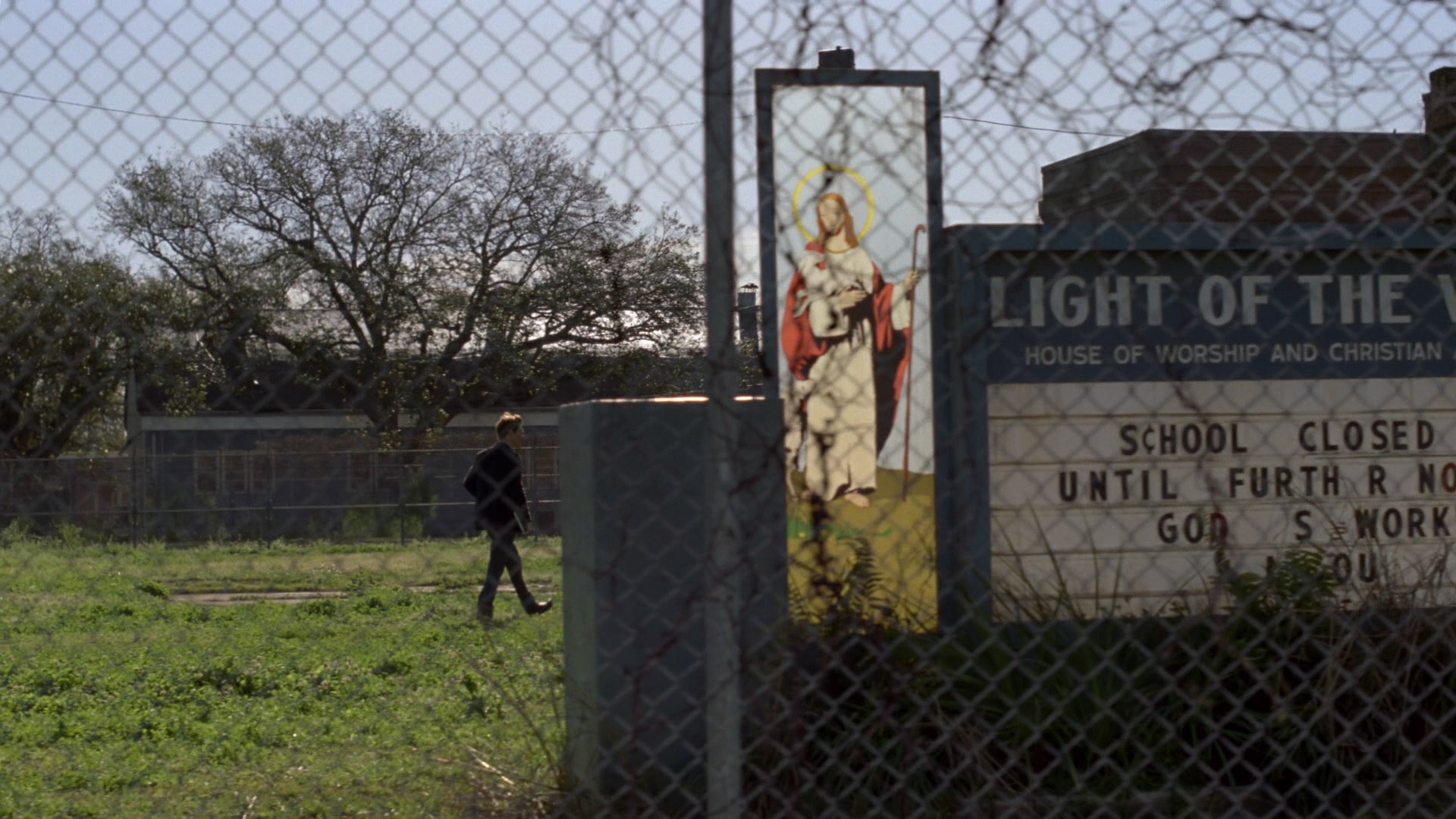
In the fifth episode, when Rust rushes after Hart in his car, the yellow crown (a Palace Truck Stop?s logomark) is literally over his head at one point:
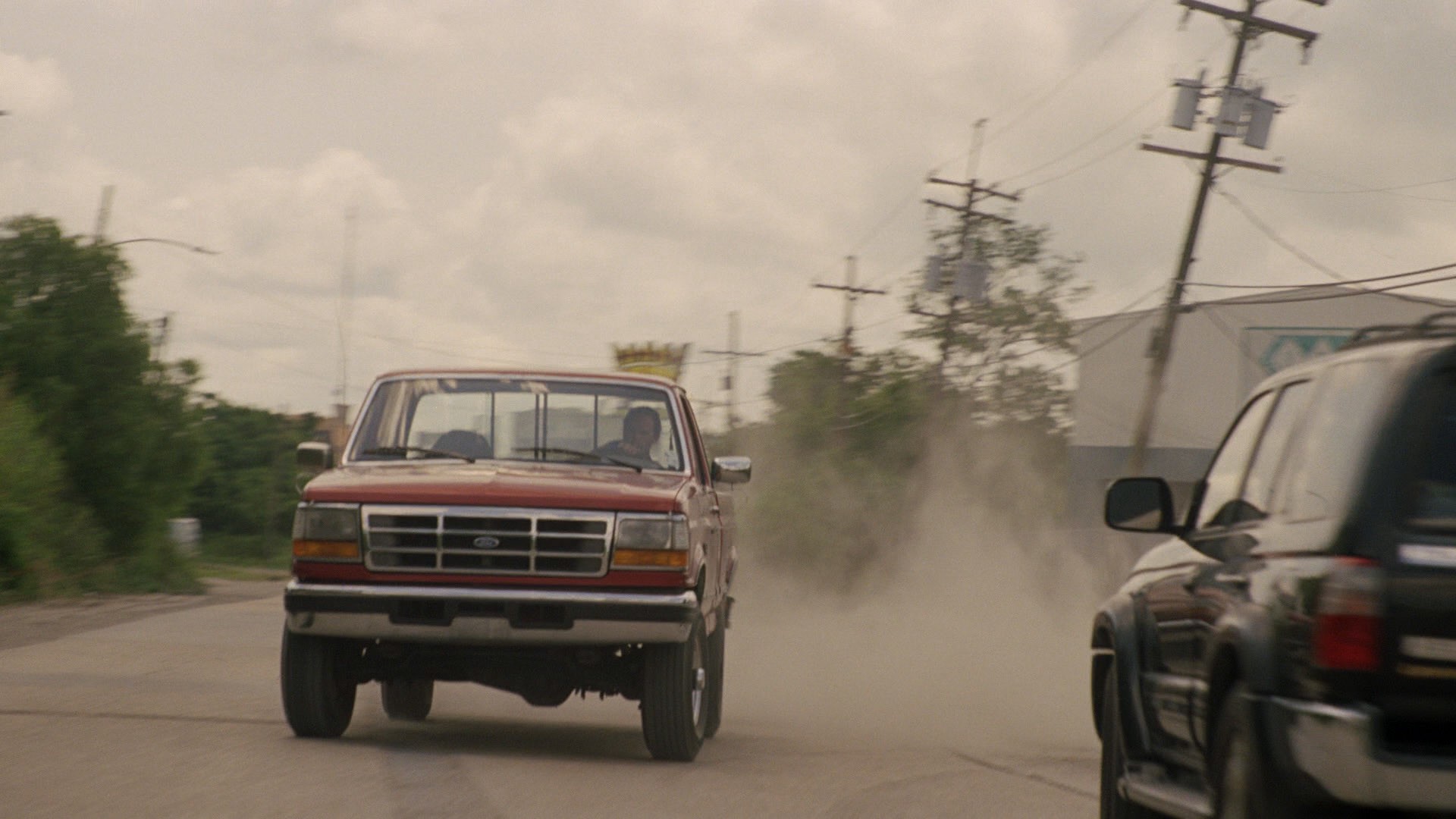
Is it all a coincidence? Who knows?
On one hand, True Detective has hundreds of Chekhov?s Guns in it, is clearly a product of many years of planning (if you include the work on the script), and the creators have confirmed that they did plant many things in the background as clues or extras.
On the other hand, well, lucky accidents happen. But if all of the above were accidents (except for the middle one, that?s on purpose for sure ? but more on that later), I like to think it?s the universe trying to help the creators out.
Anyway, so for five episodes we?re slowly getting used to the thought that, Angel Heart-style, the protagonist himself might be the killer. But what happens at the end of the fifth episode?
As it turns out, Rust is being framed. I mean, literally, this is the final shot:

And what?s the opening shot of the sixth episode? Another frame:
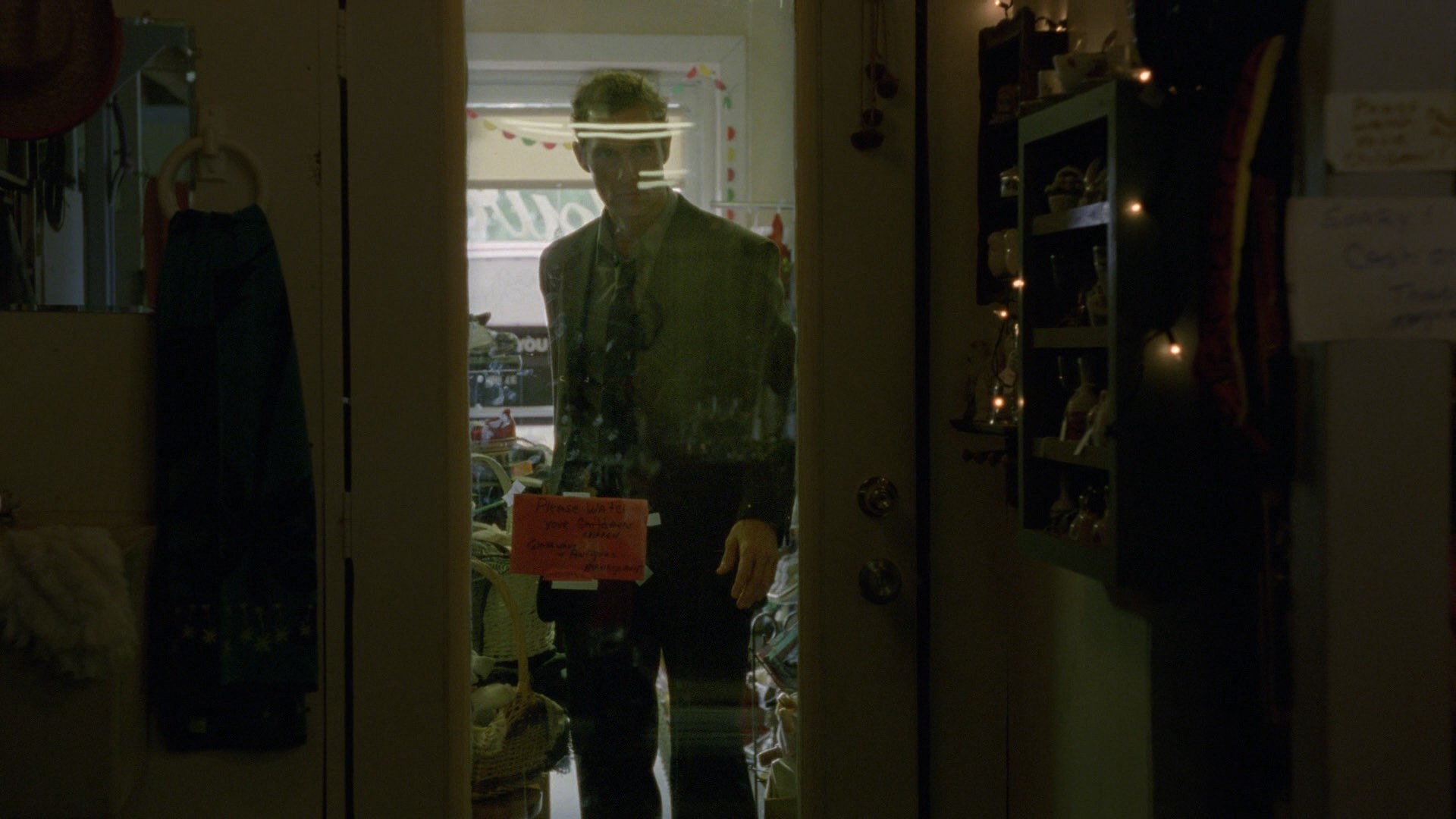
If this is indeed creators winking at us, logically they should offer the next suspect at this point. And that?s exactly what happens. In the middle of this very episode, we?re presented with another potential Yellow King:
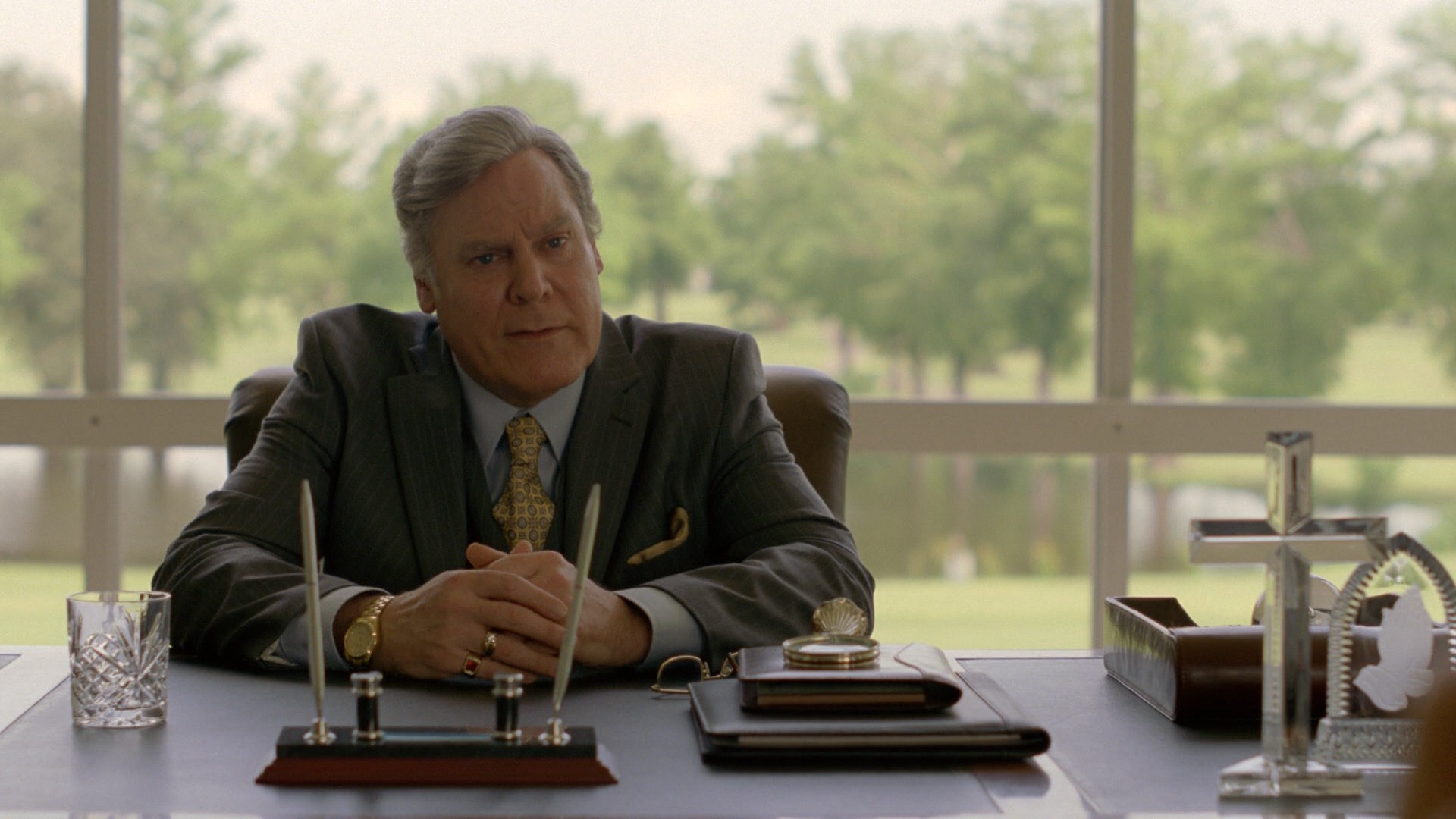
Note how Reverend Tuttle?s golden tie, watch, glasses and handkerchief are contrasted by the grey suit, hair, and desk, and silver glass and devotional items. All to emphasize the yellow.
The producers went even further than that, giving Tuttle a tie full of ?black stars? (if you watched the show, you know that ?Yellow King?, ?black stars? and ?Carcosa? are the core clues):
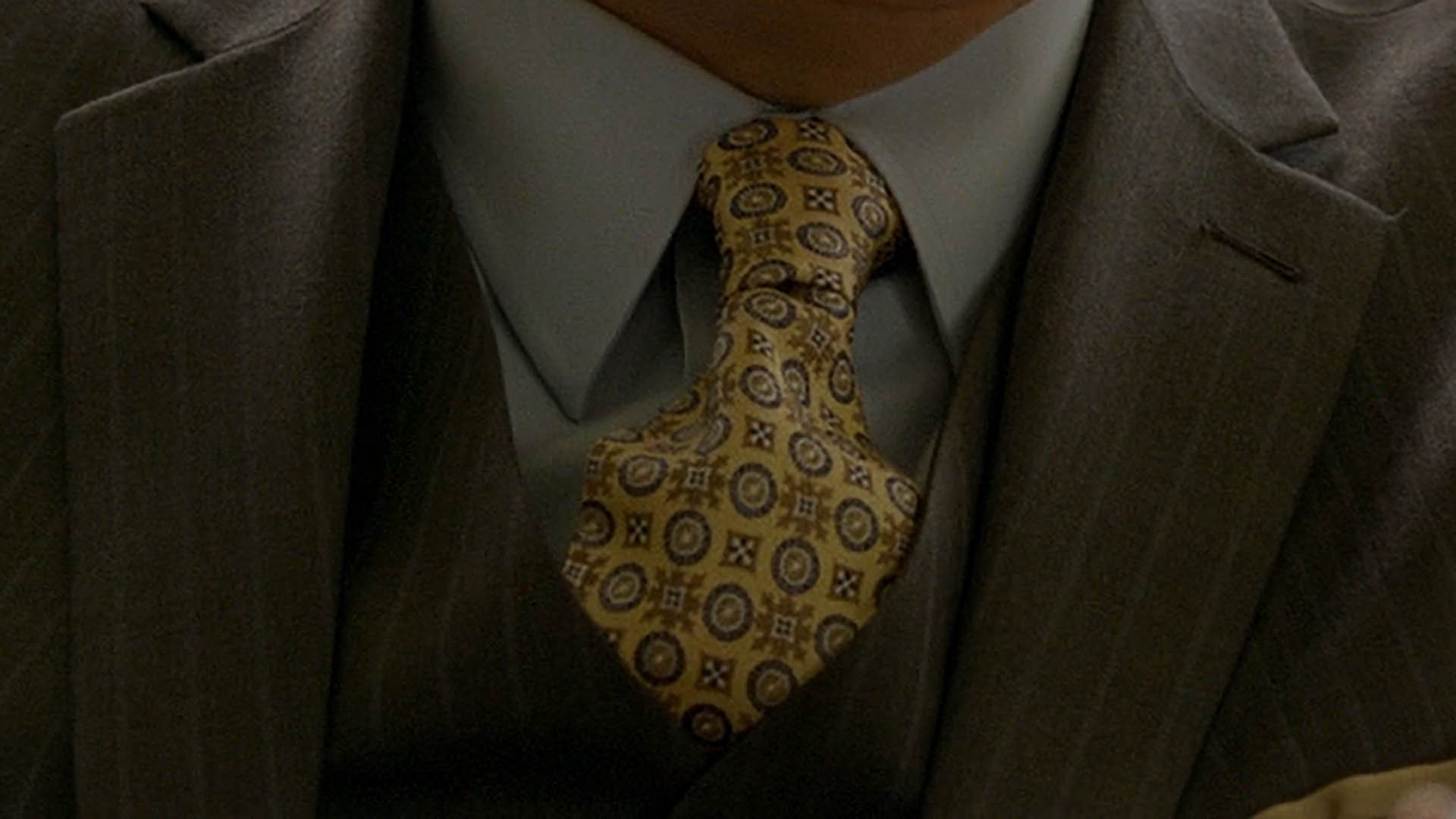
In the end, we learn that both suspects were a misdirection (however guilty Tuttle was), and killer was someone else.
Who?
Well, the creators tell us that in episode three, in one of the best reveals in TV?s history.
Look at the scene as it looks on the surface. Rust?s investigation takes him to Light of the Way Academy, a religious school run by Tuttle. He arrives at the place?

The camera pans over the board, telling us the place and telling us the school is closed:

Rust approaches a man on the lawnmower?
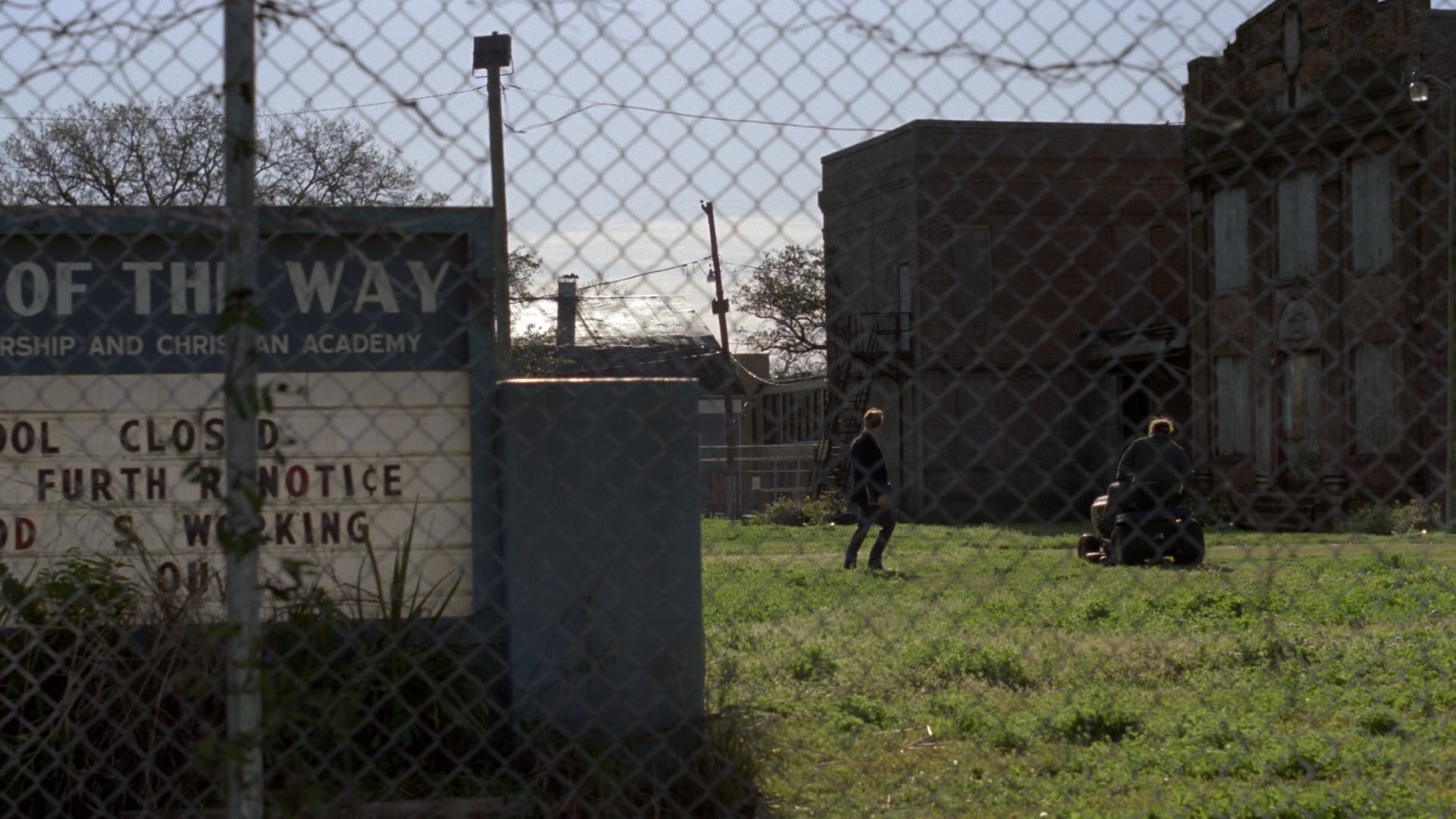
?and has a short conversation with him until Hart abruptly ends it because of the new important lead that he just got.

That?s it. Hart?s revelations take us in an exciting new (mis)direction and we forget all about the lawnmower man until the finale.
But let?s look at that scene again. Here are the clues to the identity of the killer that we get directly from the story told in the previous episodes:
- He might be called the ?Yellow King?
- He has scars on the lower part of his face
- He?s a ?giant?.
So, it?s rewind time. Once again, Rust arrives at the school?

There are two important clues in this opening shot of the sequence.
First, the already mentioned ?Yellow King?, a painting of Christ the King (as often depicted; Christ means ?an anointed one?) with a yellow halo.
Second, the tree is similar to the tree from the opening of the first episode, the tree where the body of Dora Lange was found. The killer?s mark on the world.

These two things give the scene a sense of importance and weight. It all happens on a subconscious level, but the core truth of movie symbolism is that it doesn?t matter if the viewer notices the symbolism or not: it works either way.
The camera pans over the board?

Anything important here? No?
But look again. Why are some letters missing? Why is one ?C? a regular ?C?, but the other two are kind of like a cent sign? Why are one ?O? and ?D? a dark red?
To me, all of that screams: ?I?m a puzzle. Solve me?.
And here?s the solution:

Do you ??notice king??
And also, doesn?t the lawnmower man look like a giant next to the detective?
But wait, is he the Yellow King?

Well, he does have a light yellow glasses, dark yellow gloves and some yellow paint all over his work clothes.
The last piece is the scars. Rust cannot see them. The sun is strong and in his eyes, the man has a beard, and he faces the camera the way he faces Rust. But what happens if we freeze frame ? the only way to see it ? the moment that Rust turns around and leaves the scene?

Scars happen, that?s what.
Yup, the identity of the killer was revealed in episode 3. We did not just meet him, we were also given enough clues to understand who he was.
Earlier, I said ?Sometimes, it?s a literal puzzle?? Like the one I just discussed. A fun stuff on its own, but nothing too deep. Just clever.
However, other times, it?s a puzzle with more weight and depth, one that invites you to reflect on yourself and others.
Let?s look at the moment when the killer knifes Rust. He says:

What does that mean, ?take off your mask??
As we know, the idea of Carcosa, black stars, and the Yellow King comes from the weird fiction of Robert W. Chambers, a collection of short stories called ?The King in Yellow? (1895).
Camilla: You, sir, should unmask.
Stranger: Indeed?
Cassilda: Indeed it?s time. We all have laid aside disguise but you.
Stranger: I wear no mask.
Camilla: (Terrified, aside to Cassilda.) No mask? No mask!
But what is the ?mask?? Chambers never fully explains it. The quote is from ?The King in Yellow?, a play often mentioned in the short stories, but never actually revealed in full.
Here?s Nic Pizzolatto?s (the creator of True Detective) take on it. In the third episode, we see a preacher saying these words:

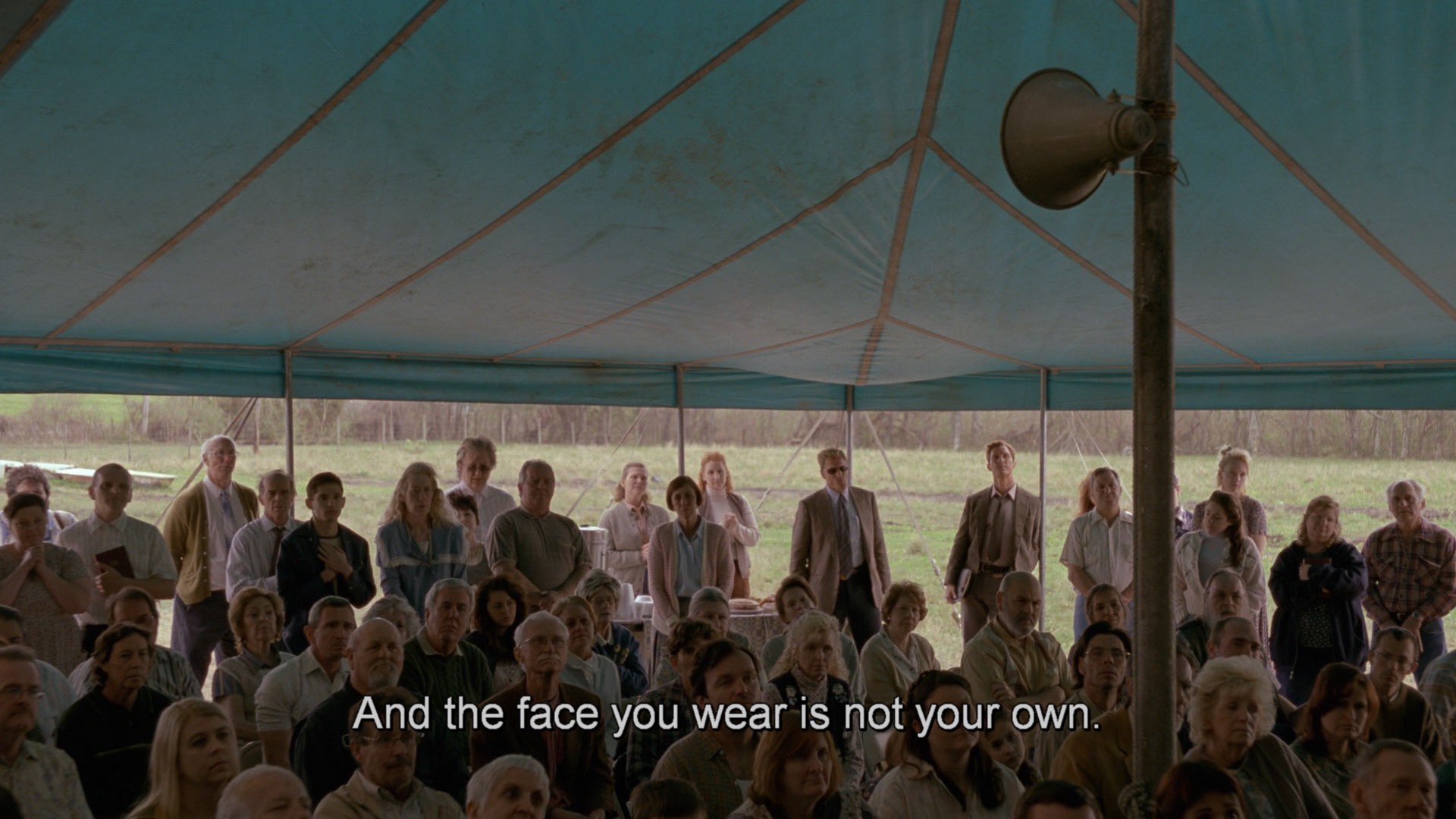
In other words, we?re not seeing the world as it truly is. But what is the truth?
The preacher, as expected, offers a comforting thought of the afterlife and heaven, and the world being an illusion hiding the face of God ? but Rust has a different idea. He starts with the general idea that our true self is a nightmare:
This cartel I worked on the border, they, uh, they had this routine. They?d duct-tape you to a chair that was bolted to the floor, use a couple rolls, make sure you couldn?t budge a fuckin? inch. And they?d cut around your face, grip your scalp, yank down, rip your face off. Hmm. And they?d put a mirror in front of you so you could get a good look at yourself.
And then, in another episode, he digs deeper into the theme. Illustrated with the photos of dead people, we hear Rust saying:
[?] This is what I mean when I?m talkin? about time, and death, and futility. [?] You look in their eyes, even in a picture, doesn?t matter if they?re dead or alive, you can still read ?em. You know what you see? They welcomed it? not at first, but? right there in the last instant. It?s an unmistakable relief. See, cause they were afraid, and now they saw for the very first time how easy it was to just? let go. Yeah they saw, in that last nanosecond, they saw? what they were. You, yourself, this whole big drama, it was never more than a jerry-rig of presumption and dumb will, and you could just let go. To finally know that you didn?t have to hold on so tight. To realize that all your life ? you know, all your love, all your hate, all your memories, all your pain ? it was all the same thing. It was all the same dream, a dream that you had inside a locked room, a dream about being a person. And like a lot of dreams, there?s a monster at the end of it.
Clearly a thought incompatible with the preacher?s idea.
Which one is the correct one? Obviously no answer is possible, the whole point is to evaluate yourself and your beliefs, what your life means to you if you?re honest with yourself and ?take off the mask?.
But it?s not as simple as a choice between the heavenly afterlife and, as Rust puts it, the pointless existence of a ?sentient meat?. In the words of Pizzolatto himself:
The show was never concerned with the supernatural, but it was concerned with supernatural thought, and it was concerned with supernatural thinking to the degree that it was concerned with storytelling. So if there was one overarching theme to True Detective, I would say it was that as human beings, we are nothing but the stories we live and die by ? so you?d better be careful what stories you tell yourself.
On the surface level, then, ?the mask? might be the lies we tell ourselves in order to cope with this life. Taking it off would be an act of cruelty.
However, when the mask that Cohle is wearing, the mask of a hardcore nihilist, is dropped when the killer nearly drains him of his life? That changes his life for the better.
What was more interesting to me is that both these men are left in a place of deliverance, a place where even Cohle might be able to acknowledge the possibility of grace in the world. Because one way both men were alike in their failures was that neither man could admit the possibility of grace. I don?t mean that in a religious sense. Where we leave Cohle, this man hasn?t made a 180 change or anything like that. He?s moved maybe 5 degrees on the meter [?]. Now they are going to go on and live forever beyond the margins of the show, and our sense, at least, is they haven?t changed in any black to white way, but there is a sense that they have been delivered from the heart of darkness. They did not avert their eyes, whatever their failings as men. And that when they exit, they are in a different place.
As we can see, ?True Detective? is about the cathartic element of story-telling, be the source of it external or internal. But the catharsis is useless unless accompanied by an honest re-evaluation (?not averting? your eyes) and follow up.
In other words, ?True Detective? is an ode to living consciously.
With the above two examples, I tried to explain what I mean when I say I love True Detective as a puzzle. If you like the idea, I highly recommend two other, much more in-depth analyses deciphering the series.
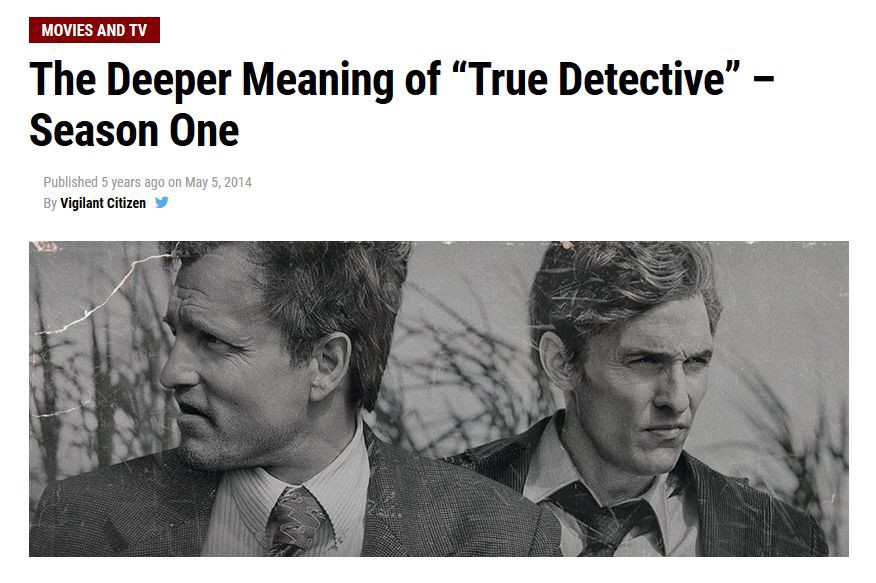
First is ?The Deeper Meaning of ?True Detective? ? Season One? on Vigilant Citizen. Don?t let the source stop you from reading (VC is an conspiracy theory website that sees any music video with a checkerboard pattern in the background as a proof of the Illuminati). Except for an odd line here and there, it?s a fantastic analysis that offers interesting answers to questions like ?Why did the killer decide to put Dora Lange?s body on display?? Just ignore the ?occult elite?obsession and you?ll get what is one of the best and most revealing articles on ?True Detective?.
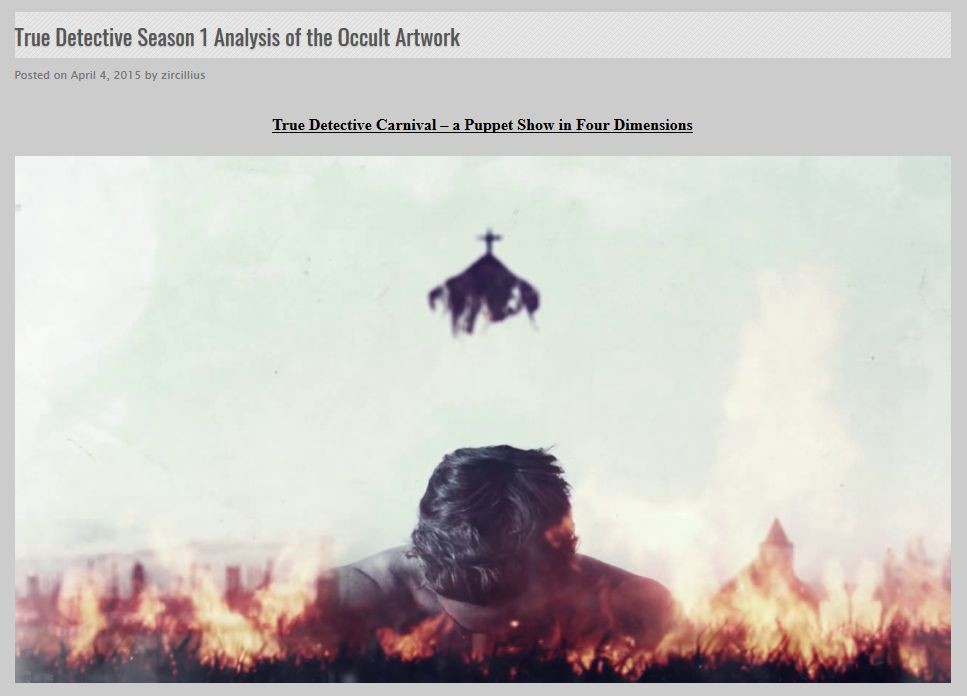
Second one is ?True Detective Season 1 Analysis of the Occult Artwork?, written by a fan, and is exactly what the title says. If anything, it shows the amount of work and thought put into the series.
Finally, let me use this opportunity to talk quickly about the other seasons. I mean quickly.
- Season 2 is not as bad as most people claim. Forget its roots and consider it a neo-noir and it?s actually pretty good. Sure, I do have issues with the ending, and oh boy not even Matthew McConaughey could pull off the lines that Vince Vaughn had to say, but still.
- Season 3 is off to a fantastic start. It?s the slowest of burns, but it?s hard not to immerse yourself in the atmosphere. Some secondary characters? acting is questionable, and I miss Pizzolatto?s signature dialogue (he went in the opposite direction this time around: simplicity), but everything else is just, once more, the best TV ever. Waiting a week for the next episode is a physical pain.
And that is all ?for now.

